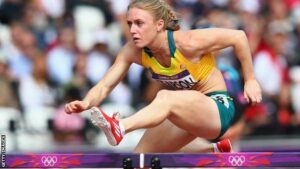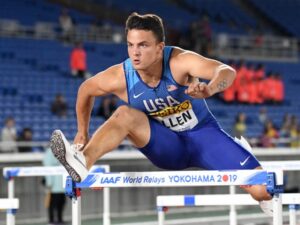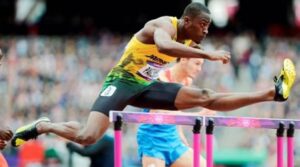Lead Leg Evolution
by Steve McGill
A few days after my fourth Team Steve Downhill Hurdling Academy concluded a few weeks ago, a coaching friend of mine, Marla Lindsay, who coaches at the collegiate level, called me. She had helped me with a couple of my camps a few years ago, back before the Covid pandemic hit, and she was calling to admonish me for not inviting her to join my staff for this one. After apologizing profusely, I got to talking with her about how our latest academy went (which I discuss in detail in another article in this month’s issue). In our discussion, Marla made it clear as to why she’s such a big proponent of the downhill hurdling style that I teach.
This style emphasizes an exaggerated knee lift at take-off so that the lead leg can cycle over the hurdle and back to the ground, as opposed to kicking and snapping. With the downhill style, the lead leg knee never locks, which enables the trail leg to come to the front sooner. The overall action is more fluid and efficient than the traditional style that everyone was using when I first got into coaching in the mid-90’s, which did involve a kicking action, and then a snapdown on the other side. I was teaching that style in my early years of coaching, and that’s the style I was taught when I first started hurdling myself in high school. As far back as my college years in the 80’s — when I didn’t have a hurdles coach and was basically coaching myself — I was already beginning to move away from the traditional style because I was hitting so many hurdles and because my hamstring (lead leg side) was always aching and my groin (trail leg side) was always aching.
Back in the day, almost all hurdlers employed the kick/snap style, even female hurdlers, whose barriers were only 33 inches and didn’t require the athletes to be as extreme with their movements to clear the barriers. In explaining why she loves the downhill style so much, Marla made an interesting observation that has been obvious for quite a few years now although I didn’t consciously notice it until she said it: “That’s how all the women are hurdling now.”
As the conversation continued, Marla credited me for spearheading the change, although I don’t know how much credit I can take, because there are plenty of intelligent coaches out there who can see what I can see. But because I’m a good writer and a good teacher, I’ve been able to articulate not just what to do but why/how it is beneficial. The idea is to create a downhill angle when attacking each hurdle so that you feel tall and the hurdle feels small, no matter how tall you are (or aren’t). I originally developed the style when coaching myself mainly as a way to stop hitting hurdles. But in my own coaching, I came to understand how faster this style enables the athlete to be when coming off each hurdle. “It’s like running down a hill,” I explained to one of my athletes one time, before I had adopted the term “downhill hurdling.” I went on to explain the obvious: when you’re running down a hill, you run faster because the angle of the hill makes you faster, not because you’re trying to run faster. So, not only are you running faster, but you’re doing so with less effort, which means it’ll be easier to sustain the movements for all ten hurdles. One of the frustrations I had with the kick/snap style was that it was so hard to execute for all ten hurdles. By the time you reached the last three hurdles, the lead leg was hanging in the air longer and the snapdown wasn’t nearly as forceful.

Camacho-Quinn demonstrates how easy it is for taller women to step over hurdles.
But back to Marla’s point, yes, all women are hurdling in the downhill style now. How much of that is my influence I’ll never know, but the fact that it’s happening is obvious. Back in Sally Pearson’s heyday, she was the only one hurdling this way. When I saw her race, and also Liu Xiang and Allen Johnson on the men’s side, that’s when I knew that there was credibility to the things I was experimenting with. Dawn Harper-Nelson also started hurdling in this manner and looked as good as Pearson doing it. Compare the Harper-Nelson of 2012 to the Harper-Nelson of 2008, and you’ll see the difference. Other great female hurdlers of previous eras like Gail Devers, Joanna Hayes, Kellie Wells, and even taller hurdlers like Ginnie Powell and Lolo Jones — they all kicked and snapped. I was coaching Keni Harrison right around the time that Sally was entering her prime, so Sally was the only hurdler whom I had Keni study. “We’re trying to do what she does,” I told her.

Pearson executing the cycling action that I taught to Keni Harrison.
Now, look across the line in any women’s race, and you’ll see lead legs that cycle, that don’t kick and snap. When Keni first started hurdling professionally, this style separated her from most of the others, and enabled her to beat women who may have had more height and flat speed. But after she ran that 12.20 back in 2016, it seems that the world caught up to her and caught on to what she was doing. In the women’s race, there really is no need to kick and snap. Women were doing so back in the day because they were copying the men and coaches were encouraging them to do so. The hurdles are so low that all that extra effort makes no sense. To demonstrate this point, I recently had a hurdler of mine who is 5-4 stand beside a 33-inch hurdle. Her waist was about an inch above the crossbar. I, who am 6-0, stood beside a 42-inch hurdle. My waist was even with the bar. So, even a “small” female is taller than a male of average height when it comes to the height of the hurdles.

Allen keeping the knee bent as he attacks through the hurdle.
On the male side of things, we do see a lot of hurdlers cycling the lead leg — the vast majority of them, but not all of them. And even among those who are doing it, you have to look a lot more closely to see it because the hurdles are so high. As mentioned earlier, Allen Johnson and Liu Xiang were the first two hurdlers I remember who didn’t kick and snap, and I used both of them as models for the hurdlers I was coaching at the time, similar to how I used Sally as a model for Keni. Nowadays, look at guys like Grant Holloway, Devon Allen, and now Cordell Tinch, and you’re seeing a lead leg that cycles. Holloway and Tinch are very tall, but Allen is not. If you were to compare Allen to, say, Omar McLeod, who is similar in height but tends to hit a lot of hurdles whereas Allen does not, I’d argue that the difference lies in their styles. The whole point of downhill hurdling is to push off the back leg forcefully in order to get the hips tall, which is so important for smaller hurdlers. If you look at Allen, he gets his hips tall (while the hips themselves push forward), whereas McLeod attacks the hurdle from more of a line-drive angle. As a result, McLeod needs to extend the lead leg and lock the knee in order to avoid “sitting” on the hurdle with his hamstring or glute. But trying to do this for a whole race is very difficult because it’s very tiring. When he’s on he’s on, but when he’s not, disaster strikes.

Parchment with the straight-leg style
One thing you can say about the men’s race is that there have always been hurdlers who kick and snap and have been very successful doing so. Back when Johnson was competing, Anier Garcia stood out to me as someone who hurdled that way and won a gold medal doing it. David Oliver is another who excelled with that style. And in today’s game there is the obvious example of Hansle Parchment. So the argument could be made that old school still works, and will always work, over 42’s. But all of the men mentioned above were/are exceptionally strong and powerful. So yes, it still works, but not for everybody, and I’d go so far as to say not for most hurdlers, male or female.
